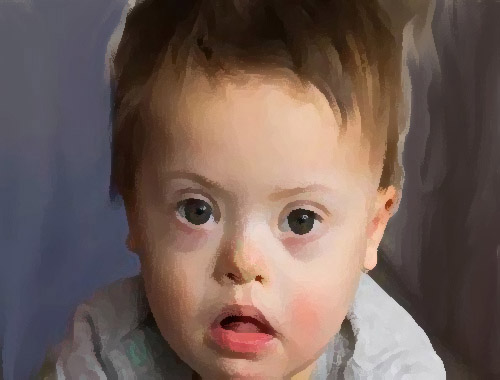Down Syndrome (Trisomy 21)

Published: 18 Jun 2025
ICD9: 758.0 ICD10: Q90.9 ICD11: LD40
Down syndrome (Trisomy 21) is a genetic disorder caused when abnormal cell division results in an extra full or partial copy of chromosome 21.
This extra genetic material alters development and causes the characteristics associated with Down syndrome.
Here's a breakdown of key aspects:
![]() Trisomy 21: The term "Trisomy 21" literally means "three copies of chromosome 21." Normally, a person has two copies of each chromosome (one inherited from each parent). In Down syndrome, there are three copies of chromosome 21, or an extra partial copy.
Trisomy 21: The term "Trisomy 21" literally means "three copies of chromosome 21." Normally, a person has two copies of each chromosome (one inherited from each parent). In Down syndrome, there are three copies of chromosome 21, or an extra partial copy.
![]() Cause: The extra genetic material is usually caused by a random error in cell division during the development of the egg or sperm. It's not typically inherited.
Cause: The extra genetic material is usually caused by a random error in cell division during the development of the egg or sperm. It's not typically inherited.
![]() Characteristics: Down syndrome is associated with a range of physical characteristics, developmental delays, and intellectual disabilities. These can vary widely in severity from person to person. Common characteristics include:
Characteristics: Down syndrome is associated with a range of physical characteristics, developmental delays, and intellectual disabilities. These can vary widely in severity from person to person. Common characteristics include:![]()

![]() Physical features:
Physical features:![]()

![]() Flattened facial features, especially the bridge of the nose
Flattened facial features, especially the bridge of the nose![]()

![]() Small head and ears
Small head and ears![]()

![]() Short neck
Short neck![]()

![]() Protruding tongue
Protruding tongue![]()

![]() Upward slanting eyes (palpebral fissures)
Upward slanting eyes (palpebral fissures)![]()

![]() Atypical shaped ears
Atypical shaped ears![]()

![]() Poor muscle tone (hypotonia)
Poor muscle tone (hypotonia)![]()

![]() Shorter height
Shorter height![]()

![]() Single deep crease across the palm of the hand (simian crease)
Single deep crease across the palm of the hand (simian crease)![]()

![]() White spots on the colored part (iris) of the eye called Brushfield spots.
White spots on the colored part (iris) of the eye called Brushfield spots.![]()

![]() Developmental and Cognitive:
Developmental and Cognitive:![]()

![]() Intellectual disability, usually mild to moderate
Intellectual disability, usually mild to moderate![]()

![]() Delayed speech and language development
Delayed speech and language development![]()

![]() Slower development of motor skills (sitting, crawling, walking)
Slower development of motor skills (sitting, crawling, walking)![]()

![]() Health Issues:
Health Issues:![]()

![]() Congenital heart defects (present at birth) are common.
Congenital heart defects (present at birth) are common.![]()

![]() Hearing loss
Hearing loss![]()

![]() Vision problems (cataracts, nearsightedness, etc.)
Vision problems (cataracts, nearsightedness, etc.)![]()

![]() Sleep apnea
Sleep apnea![]()

![]() Thyroid problems
Thyroid problems![]()

![]() Increased risk of certain infections
Increased risk of certain infections![]()

![]() Increased risk of leukemia in childhood
Increased risk of leukemia in childhood![]()

![]() Increased risk of early-onset Alzheimer's disease.
Increased risk of early-onset Alzheimer's disease.
![]() Diagnosis:
Diagnosis:![]()

![]() Down syndrome can be diagnosed during pregnancy through prenatal screening and diagnostic tests.
Down syndrome can be diagnosed during pregnancy through prenatal screening and diagnostic tests.![]()

![]() After birth, it is typically diagnosed based on physical characteristics, followed by a chromosome analysis (karyotype) to confirm the presence of trisomy 21.
After birth, it is typically diagnosed based on physical characteristics, followed by a chromosome analysis (karyotype) to confirm the presence of trisomy 21.
![]() Management and Treatment:
Management and Treatment:![]()

![]() There is no cure for Down syndrome.
There is no cure for Down syndrome.![]()

![]() Management focuses on addressing individual needs and maximizing potential through:
Management focuses on addressing individual needs and maximizing potential through:![]()

![]() Early intervention programs (physical therapy, speech therapy, occupational therapy)
Early intervention programs (physical therapy, speech therapy, occupational therapy)![]()

![]() Special education
Special education![]()

![]() Medical care to address health issues
Medical care to address health issues![]()

![]() Supportive environment
Supportive environment
![]() Prognosis:
Prognosis:![]()

![]() Life expectancy for individuals with Down syndrome has increased dramatically over the past few decades, largely due to improved medical care. Many individuals with Down syndrome now live into their 60s or beyond.
Life expectancy for individuals with Down syndrome has increased dramatically over the past few decades, largely due to improved medical care. Many individuals with Down syndrome now live into their 60s or beyond.![]()

![]() With appropriate support and care, individuals with Down syndrome can lead fulfilling lives, attend school, participate in activities, work, and form relationships.
With appropriate support and care, individuals with Down syndrome can lead fulfilling lives, attend school, participate in activities, work, and form relationships.
![]() Important Considerations:
Important Considerations:![]()

![]() People with Down syndrome are individuals with their own unique personalities, strengths, and challenges.
People with Down syndrome are individuals with their own unique personalities, strengths, and challenges.![]()

![]() Generalizations should be avoided; each person with Down syndrome is different.
Generalizations should be avoided; each person with Down syndrome is different.![]()

![]() Focusing on abilities and providing support is crucial for promoting independence and quality of life.
Focusing on abilities and providing support is crucial for promoting independence and quality of life.![]()

![]() Outdated and offensive terms should be avoided.
Outdated and offensive terms should be avoided.
In summary, Down syndrome is a genetic condition resulting from an extra copy of chromosome 21. It leads to a characteristic set of physical features, developmental delays, and health issues. With appropriate care and support, individuals with Down syndrome can live meaningful and fulfilling lives.